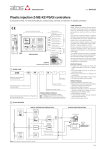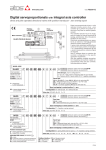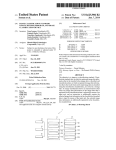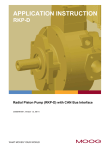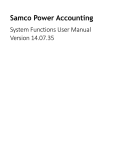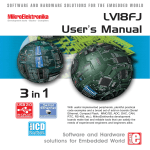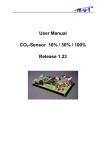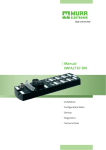Download Digital position Z-ME-KZ controllers
Transcript
www.atos.com Table G340-7/E Digital position Z-ME-KZ controllers Eurocard format, for electrohydraulic closed loop controls Z-ME-KZ MAIN FUNCTIONS AND FEATURES USER INTERFACE SUPPLY 24V POSITION REFERENCE ENT ESC UP DWN X1 X2 O1 O2 O3 O4 O5 O6 O7 A3 A4 A5 POSITION FEEDBACK Position control Alternated control Real-time fieldbus Serial port FORCE FEEDBACK AUXILIARY INPUT Internal reference DRIVER’S COMMAND Enhanced diagnostic OUTPUTS I1 I2 I3 I4 I5 I6 I7 I8 A1 A2 P/Q RS232 INPUTS FORCE REFERENCE OK MONITOR PROFIBUS Z-ME-KZ AUXILIARY OUTPUT Z-ME-KZ Z-SW-PS programming software 1 Z-SW-PS MODEL CODE - Z-ME KZ - PS / * / * / * Electronic axis controller in Eurocard format Electrical Features: • 4 digits front panel display to check and change parameters as well as for diagnostics • Front panel DB9 connector for serial programming interface • Front panel test points for debug and maintenance • Eurocard format (DIN 41494 - Plug-in-units) • CE mark according to EMC directive Set code Alternated position / force (or position / pressure) control module Series number Serial communication interface for configuration and monitoring function 2 SW -PS Optional fieldbus interfaces: - = standard without fieldbus interface BC = CANopen communication interface BP = PROFIBUS DP communication interface BLOCK DIAGRAM DIGITAL CONTROLLER Z-ME-KZ SETPOINT GENERATOR PROPORTIONAL VALVE POSITION CONTROL INT FIELDBUS NETWORK Software Features: • Internal generation of motion cycle • Setting of axis’s dynamic response (PID) to optimize the application performances • Software selectable range of electronic reference analog inputs: voltage or current • Enhanced diagnostics of the axis status • Intuitive graphic interface • In field firmware update through standard serial communication • Internal oscilloscope function SERIAL PORT Z-SW-PS SOFTWARE PID EXT FIELDBUS FORCE CONTROL M I N PID MONITOR DIGITAL I/O MACHINE CENTRAL UNIT Digital axis controllers perform the position closed loop of linear or rotative hydraulic axes. The controller receives a position feedback from the axis transducer and it generates a reference signal to the proportional valve which regulates the hydraulic flow to the actuator. The position feedback interfaces are SSI, incremental encoder, potentiometer or standard analog inputs (voltage or current) software selectable. A front panel serial port is always present for configuration and monitoring of the controller. The controller can be operated in real time by external or internally generated reference signal. With external reference signal the actuator’s motion cycle can be managed by either analog or fieldbus reference input. With internally generated reference signal the actuator’s motion cycle can be managed by external or fieldbus on/off commands. A pressure/force alternated control may be set by software additionally to the position control: a pressure/force transducer has to be assembled into the actuator and connected to the controller; a second reference pressure/force signal is required. Several auxiliary digital inputs/outputs are available and they can be used to synchronize other machine functions and to transmit information on the controller state. FORCE / PRESSURE FEEDBACK POSITION FEEDBACK HYDRAULIC ACTUATOR Note: Block diagram example for alternated position/force control, with fieldbus interface. G340 3 POSITION REFERENCE MODE 3.1 External reference generation External reference generation Z-ME-KZ controller regulates in closed loop the actuator position according to an external reference position signal and to the position feedback from the actuator transducer. It generates a reference signal for the proportional valve which regulates the hydraulic flow to the actuator. Analog (a) or Fieldbus (b) reference Machine central unit ENT ESC Valve command and monitor position I1 I2 I3 I4 I5 I6 I7 I8 A1 A2 The external reference signal can be software selected among: Analog reference (a) The controller receives in real time the reference signal from the machine electronic central unit by means of the analog input (see section 10 ) limiting speed, acceleration and deceleration values. t X1 O1 O2 O3 O4 O5 O6 O7 A3 A4 A5 X2 PROFIBUS RS232 M UP DWN OK Z-ME-KZ Fieldbus reference (b) The controller receives in real time the reference signal from the machine electronic central unit by means of the digital fieldbus communication (BC and BP executions) limiting speed, acceleration and deceleration values. Internal reference generation On-off (c) or Fieldbus (d) commands For fieldbus communication details, please refer to the controller user manual (see section 12 ). Machine central unit 3.2 Internal reference generation The internal reference signal is generated by a pre-programmed cycle; only start, stop and switch-over commands are required from the machine electronic central unit by means of: pos I1 I2 I3 I4 I5 I6 I7 I8 A1 A2 O1 O2 O3 O4 O5 O6 O7 A3 A4 A5 X1 X2 PROFIBUS RS232 M UP DWN OK Speed profile generated - on-off commands (c) ENT ESC Valve command and monitor Z-ME-KZ controller regulates in closed loop the actuator position according to an internally generated reference position signal and to the position feedback from the actuator transducer. It generates a reference signal for the proportional valve which regulates the hydraulic flow to the actuator. Z-ME-KZ switch-over points - fieldbus commands (d) Z Atos PC software allows to design a customized sequence of motion phases adapted to the specific application requirements: a range of predefined standard sequences are available in the Z-SW software. Start/stop/switch-over commands and reference generation type can be set for each phase in order to realize an automatic cycle according to the application requests. Refer to the controller user manual for further details on the available selection of start/stop/switch-over commands and reference generation type. Start/stop/switch-over commands examples External digital input on-off commands, on rear connector, are used to start/stop the cycle generation or to change the motion phase External fieldbus input on-off commands, by fieldbus communication, are used to start/stop the cycle generation or to change the motion phase Switch by position switch-over from actual to following motion phase occurs when the actual position reaches a programmed value Switch by time switch-over from actual to following motion phase occurs after a fixed time, starting from the actual phase activation Switch by internal status switch-over from internal status are used to start/stop the cycle generation or to change the motion phase Internal reference generation types examples Absolute a target position reference signal is internally generated for each motion phase; maximum speed, acceleration and deceleration can be set to obtain a smooth and precise position control Relative as ‘Absolute’ but the target position corresponds to the actuator position plus a fixed quote internally set by software Hold the controller holds the actual position 4 forward force movement control POSITION / PRESSURE OR FORCE CONTROL backward force movement control Alternated pressure or force control can be added to the actuator’s standard position control (see below functional schemes). Remote transducers (pressure or force) have to be installed on the actuator. Speed profile generated The position/pressure (or position/force) controls are operated according to two separate reference signals and a dedicated algorithm automatically selects which control is active time by time. The dynamics of the switching between the two controls can be regulated thanks to specific software setting, in order to avoid instability and vibrations. t Position control is active (see phase and at side) when the actuator actual pressure or force is lower than the relevant reference signal. reference value actual value force Pressure or force control is active (see phase and at side) when the actuator actual pressure or force, measured by remote transducers, grows up to the relevant reference signal - the controller reduces the valve’s regulation in order to limit the actuator pressure or force; if the pressure or force tends to decrease under its reference signal, the position control returns active. Alternated Position/Pressure Control ENT ESC Alternated Position/Force Control - Load cell O1 O2 O3 O4 O5 O6 O7 A3 A4 A5 I1 I2 I3 I4 I5 I6 I7 I8 A1 A2 X1 ENT ESC X1 DRIVER RS232 PROFIBUS X1 RS232 B PROFIBUS P DRIVER A RS232 B Z-ME-KZ T P X2 DRIVER A Z-ME-KZ PROFIBUS P T A B P T Z-ME-KZ T T P one remote pressure transducer has to be installed on the actuator’s port to be controlled T valve’s spool transducer O1 O2 O3 O4 O5 O6 O7 A3 A4 A5 I1 I2 I3 I4 I5 I6 I7 I8 A1 A2 X2 UP DWN OK O1 O2 O3 O4 O5 O6 O7 A3 A4 A5 I1 I2 I3 I4 I5 I6 I7 I8 A1 A2 P X2 M ENT ESC UP DWN OK Alternated Position/Force Control - Two pressure transducers L M M UP DWN OK t T one load cell transducer has to be installed between the actuator and the controlled load M actuator’s position transducer P two remote pressure transducers have to be installed on the actuator’s ports; the actuator force is calculated by the pressure feedbacks (Pa - Pb) pressure transducer L load cell APPLICATION EXAMPLES 5 Hydraulic steering wheel in marine applications Position control Position ENT ESC UP M DWN OK O1 O2 O3 O4 O5 O6 O7 A3 A4 A5 I1 I2 I3 I4 I5 I6 I7 I8 A1 A2 X1 Rudder controls on motor yachts and sail boats requires smooth control for precise and reliable operations. Z-ME-KZ controllers perform the rudder position control system, ensuring accurate and repetitive regulations for a comfortable ride, thanks to: X2 t PROFIBUS RS232 Z-ME-KZ - analog position reference mode for real time controls - potentiometer position transducer for simple and compact solution - position PID control parameters to optimize the system response - complete diagnostic information for advanced system monitoring DRIVER A B P T T Wind turbines Position control Position ENT ESC M DWN OK The pitch control of the rotor blades is required to maximize the energy production. Accurate positioning, decentralized intelligence as well as long service life and reliability are required. UP O1 O2 O3 O4 O5 O6 O7 A3 A4 A5 I1 I2 I3 I4 I5 I6 I7 I8 A1 A2 X1 X2 t - SSI digital position transducer for high precision control - complete remote system management with fieldbus interface - position PID selection to adapt the position control to the different wind conditions PROFIBUS RS232 Z-ME-KZ controllers perform high quality regulation of the blade pitch simplifying the system architecture, thanks to: Z-ME-KZ DRIVER A B P T T Position control ENT ESC Speed profile generated Wood machinery Hydraulic wood machines require configurable and repetitive motion profiles, accurate position controls, and digital signals for synchronization purpose. UP DWN OK O1 O2 O3 O4 O5 O6 O7 A3 A4 A5 I1 I2 I3 I4 I5 I6 I7 I8 A1 A2 X1 Z-ME-KZ controllers allow remote control, thanks to: X2 P t PROFIBUS RS232 Pressure Z-ME-KZ - internal reference generation with maximum speed and acceleration settings - analog position transducer for simple and reliable solution - pressure transducer for alternated pressure control - fieldbus connection for remote parameterization, commands, and controller state indication M DRIVER A B P T T t Bending Machines Position control Speed profile generated ENT ESC UP DWN OK O1 O2 O3 O4 O5 O6 O7 A3 A4 A5 I1 I2 I3 I4 I5 I6 I7 I8 A1 A2 X1 M X2 P t PROFIBUS RS232 - internal reference generation to simplify the machine control cycle - digital position sensor for high resolution measurement system - two pressure transducers for alternated force control - fieldbus interface for easy machine control integration - auxiliary digital outputs for system status indication (target reached, force control active) Force DRIVER A B P T T t Die-casting machinery Position control Speed profile generated ENT ESC Z-ME-KZ controller combine high level position regulation with accurate force control to provide in a single device a complete and dedicated solution, thanks to: P Z-ME-KZ UP Clamp movements in die-casting phases involve fast/slow motion cycle with accurate and repetitive alternated position/force controls for the mould safety functions. DWN OK O1 O2 O3 O4 O5 O6 O7 A3 A4 A5 I1 I2 I3 I4 I5 I6 I7 I8 A1 A2 X1 M Z-ME-KZ controllers, with alternated position/force control, simplify the hydraulic + electronic system architecture, thanks to: X2 P RS232 Machine tools for cold-forming flat sheets require complete, automatic, programmable and flexible machine control to produce sheet metal panels from punched blank. PROFIBUS t - internal reference generation for repetitive working cycles - SSI digital position transducer for accurate axis control - two pressure transducers for alternated force control - auxiliary digital inputs/output to synchronize the machine functions - fieldbus connection for machine remote control and advanced diagnostics P Z-ME-KZ Force DRIVER T A B P T T t G340 6 MAIN CHARACTERISTICS Power supply (see 11.1) Nominal: +24 VDC Rectified and filtered: VRMS = 20 ÷ 32 VMAX (ripple max 10 % VPP) Max power consumption 10 W Position transducer SSI, incremental encoder, potentiometer, analog Input range : voltage ±10 VDC current 0 ÷ 20 mA Output range : voltage ±10 VDC @ max 10 mA current 0 ÷ 20 mA @ max 500 W load resistance Input range : 0 ÷ 5 VDC (OFF state), 16 ÷ 24 VDC (ON state), 5 ÷ 16 VDC (not accepted); Input impedance: Ri > 10 kW Digital Outputs (1) Output range : 0 ÷ 24 VDC ( ON state > [power supply - 2 V] ; OFF state < 1 V ) @ max 30 mA Enable input Range : 0 ÷ 5 VDC (OFF state), 16 ÷ 24 VDC (ON state), 5 ÷ 16 VDC (not accepted); Input impedance: Ri > 10 kW Fault output (1) Output range : 0 ÷ 24 VDC ( no fault state > [power supply - 2 V] ; fault state < 1 V ) @ max 50 mA Analog reference outputs ±10 VDC @ max 30 mA Inceremental encoder power supply +5 VDC @ max 100 mA Alarms Position transducer out of range, analog input out of range Card format Eurocard 100x160 mm (Plug-in unit DIN 41494) Card rear connector Male DIN EN 60603/G. Available frame snap connector type E-K-64M (see tech table G800) To be ordered separately Operating temperature 0 ÷ +50 °C (storage -20 ÷ +70 °C) Front panel dimensions 128,4 x 40 mm Mass Approx. 250 g Electromagnetic compatibility (EMC) According to Directive 2004/108/CE (Immunity: EN 50082-2; Emission: EN 50081-2) Communication interface Serial Atos ASCII coding CANopen EN50325-4 + DS408 PROFIBUS EN50170-2/IEC61158 Communication physical layer not insulated serial RS232 optical insulated CAN ISO11898 optical insulated RS485 Analog Inputs Analog Outputs Digital Inputs input impedance: input impedance: Ri > 100 kW Ri < 500 W Note: (1) external negative voltage not allowed (e.g. due to inductive loads) 7 TRANSDUCER CHARACTERISTICS 7.1 Position transducers The accuracy of the position control is strongly dependent to the selected position transducer. Four different transducer interfaces are available on the controller, depending to the system requirements: potentiometer, analog signal, SSI, and encoder, see 7.3. Transducers with digital interface (SSI and encoder) allow the user to get high resolution and accurate measures. Transducers with analog interface (potentiometer and analog signal) grant simple and cost effective solutions. 7.2 Pressure/force transducers The accuracy of the pressure/force controls is strongly dependent to the selected pressure/force transducers (see section 4 ). Alternated pressure/force controls require to install pressure transducers or load cell to measure the actual pressure/force values. Pressure transducers allow easy system integration and cost effective solution for both alternated position/pressure and position/force controls (see tech table G465 for pressure transducers details). Load cell transducers allow the user to get high accuracy and precise regulations for alternated position/force controls. The characteristics of the remote pressure/force transducers must be always selected to match the application requirements and to obtain the best performances: transducer nominal range should be at least 115%÷120% of the maximum regulated pressure/force. 7.3 Transducers characteristics & interfaces - following values are just for reference, for details please consult the transducer’s datasheet Position Input type Pressure/Force Potentiometer Analog SSI Incremental Encoder Analog ±10 VDC +24 VDC +5 VDC / +24 VDC +5 VDC / +24 VDC +24 VDC ±10V 0 ÷ 10V 4 ÷ 20 mA Serial SSI binary/gray TTL 5Vpp - 150 KHz ±10 VDC 4 ÷ 20 mA 0,5 m/s 1 m/s 2 m/s 2 m/s - Max Resolution < 0.4 % FS < 0.2 % FS 1 mm 1 mm (@ 0.15 m/s) < 0.4 % FS Linearity error (2) ± 0.1% FS < ±0.03% FS < ± 0.01 % FS < ± 0.001 % FS < ±0.25% FS Repeatability (2) ± 0.05% FS < ± 0.005% FS < ± 0.001 % FS < ± 0.001 % FS < ±0.1% FS Power supply (1) Controller Interface Max speed Notes: (1) power supply provided by digital controller (2) percentage of total stroke 8 FRONT PANEL DESCRIPTION 9 FRONT PANEL VIEW 8.1 Keyboard and display On the Z-ME-KZ front panel are available 4 function keys (ESC, ENT, UP, DWN), and a numeric display (4 digits plus sign) to allow the user to view and change the controller’s parameters as well as to display diagnostic messages. The following parameters can be accessed (viewed or changed) via corresponding menu structure: - command and actual values - analog input / output values - digital input / output status - position sensor indication - force / pressure sensor indication Parameter’s changes of the configuration, control gains, trigger conditions, internal cycle, fault monitoring are not allowed via front panel operations. Function Keys Display ENT ESC UP OK Led OK Active Led Digital Input Led Digital Output Led Auxiliary Led 8.2 LED indication The led indications are used to display the internal status (Active, OK) of the controller or the status of the digital IO of the Z-ME-KZ. There are 22 led divided in four different types: - internal controller’s status (Active - OK) - digital input status (I1 ÷ I8) - digital output status (O1 ÷ O7) - software programmable led (A1 ÷ A5) for specific functions DWN O1 O2 O3 O4 O5 O6 O7 A3 A4 A5 I1 I2 I3 I4 I5 I6 I7 I8 A1 A2 X1 X2 Test Points RS232 serial programming port 8.3 Test points PROFIBUS RS232 PROFIBUS-DP port (*) The test points present on the controller front panel can be used to monitor the actual position (X1) and the force / pressure (X2) value measured by the relevant transducers. Both signals are referred to the analog ground (┴) pin. The two signals are respectively connected to P_MONITOR+ (X1) and F_MONITOR+ (X2) analog output present on the rear connector of the controller card. These signals can be software set to show other signals available in the controller (see 11.8 and 11.9). Z-ME-KZ (*) only for BP option 8.4 Communication ports On the front panel of the Z-ME-KZ is always present a serial RS232 port to program the controller by the Atos Z-SW software (see section 12 ). All the functional parameters of digital controller, like internal reference generation, controller dynamics, IO configurations, can be easily set and optimized by the user. For BP or BC options a second communication port dedicated to the selected fieldbus connection is present on the controller. For BP option the PROFIBUS-DP port is located on the front panel of the Z-ME-KZ controller. For BC option the CANopen connection is located on the rear connector of the Z-ME-KZ controller. Through the fieldbus communication only the real-time parameters may be exchanged: - position, velocity and force / pressure reference - position, velocity and force / pressure feedback - controller commands and status - diagnostic / error messages For more information about the front panel settings and fieldbus communication, please refer to the controller user manual. 10 ELECTRONIC CONNECTIONS - 64 PIN REAR CONNECTOR f d b z pin f d b z 2 DO 7 (O) DI 1 (I) F_TR2 + (I) nc 4 SSI clock + (D) DI 2 (I) F_TR2 - (I) nc 6 SSI clock - (D) DI 3 (I) F_INPUT + (I) nc 8 SSI data + / Inc Ua1 (D) DI 4 (I) F_INPUT - (I) nc 10 SSI data - / Inc /Ua1 (D) DI 5 (I) P_INPUT + (I) nc 2 4 6 8 10 12 12 Inc Ua2 (D) DI 6 (I) P_INPUT - (I) nc 14 Inc /Ua2 (D) DI 7 (I) F_TR1 + (I) nc 16 Inc Ua0 (D) DI 8 (I) F_TR1 - (I) nc 18 Inc /Ua0 (D) ENABLE (I) P_TR + (I) nc 20 Inc +5VDC (O) DO 1 (O) P_TR - (I) GND 22 nc FAULT (O) VALVE_MONITOR + (I) DO 3 (O) 24 nc nc VALVE_MONITOR - (I) DO 4 (O) 26 nc DO 2 P_MONITOR + (O) DO 5 (O) 28 CAN_GND (F) DO 6 (O) 30 CAN_L (F) 32 CAN_H (F) 14 16 18 20 22 24 26 (O) 28 nc AGND 30 CONTROL_OUTPUT + (O) VREF -10VDC (O) V+ (PS) VREF +10VDC (O) V0 (PS) 32 rear view F_MONITOR + (O) (I) Input - (O) Output - (D) Digital transducers - (PS) Power supply - (F) Fieldbus interface, only for BC option G340 11 SIGNAL SPECIFICATIONS Atos digital controllers are CE marked according to the applicable directives (e.g. Immunity/Emission EMC Directive). Installation, wirings and start-up procedures must be performed according to the prescriptions shown in tech table F003 and in the user manuals included in the Z-SW programming software. The electrical signals of the controller (e.g. monitor signals) must not be directly used to activate safety functions, like to switch-ON/OFF the machine’s safety components, as prescribed by the European standards. 11.1 Power supply (V+ and V0) The power supply must be appropriately stabilized or rectified and filtered: apply at least a 10000 mF/40 V capacitance to single phase rectifiers or a 4700 mF/40 V capacitance to three phase rectifiers. The controller is protected against overloads by a internal safety fuse: 3,15 A fuse. 11.2 Position reference input signal (P_INPUT+, P_INPUT-) The controller allows to regulate the axis position in closed loop according to an external voltage or current reference input signal (P_INPUT+ and P_INPUT-), see 3.1. The analog input is a differential input type. The input range and polarity are software selectable within the maximum range ±10 VDC for voltage or 0 ÷ 20 mA for current; default setting is 0 ÷ 10 VDC. Controller with fieldbus interface (BC or BP) can be software set to receive reference value directly by the machine electronic control unit (fieldbus master); in this case the analog reference input signal can be used for start-up and maintenance operations. 11.3 Pressure or force reference input signals (F_INPUT+, F_INPUT-) For alternated position/force (or position/pressure) control the Z-ME-KZ receives a second analog voltage or current reference input signal (F_INPUT+,F_INPUT-) dedicated to the force (or pressure) closed loop control (see section 4 ).The analog input is a differential input type. The input range and polarity are software selectable within the maximum range ±10 VDC for voltage or 0 ÷ 20 mA for current; default setting is 0 ÷ 10 VDC. Controller with fieldbus interface (BC or BP) can be software set to receive reference value directly by the machine electronic control unit (fieldbus master); in this case the analog reference input signals can be used for start-up and maintenance operations. 11.4 Position transducer input signal A position transducer must be always directly connected to the controller: digital SSI (SSI clock+, SSI clock-, SSI data+, SSIdata-), digital Encoder (Inc Ua1, Inc /Ua1, Inc Ua2, Inc /Ua2,Inc Ua0, Inc /Ua0), potentiometer or a generic transducer with analog interface (P_TR+, P_TR-) can be used. For transducers with analog interface the input range and polarity are software selectable within the maximum range ±10 VDC for voltage or 0 ÷ 20 mA for current; default setting is 0 ÷ 10 VDC. Refer to position transducer characteristics to select the transducer type that maches the specific application requirements (see 7.1). 11.5 Force / pressure transducer input signal (F_TR1+, F_TR1-, F_TR2+, F_TR2-) Analog remote pressure transducers or load cell with maximum ±10 VDC signal range must be directly connected to the controller in case of alternated postion/force (or position/pressure) control. Refer to pressure/force transducer characteristics to select the transducer type that mach the specific application requirements (see 7.2). The input range and polarity are software selectable within the maximum range ±10 VDC for voltage or 0 ÷ 20 mA for current; default setting is 0 ÷ 10 VDC. 11.6 Analog valve monitor input signal (VALVE_MONITOR+, VALVE_MONITOR-) The controller allows to monitor the regulation of the proportional valve which operates the hydraulic flow to the actuator (VALVE_MON+,VALVE_MON-). The analog input is a differential input type. The input range and polarity are software selectable within the maximum range ±10 VDC for voltage or 0 ÷ 20 mA for current; default setting is 0 ÷ 10 VDC. 11.7 Control output signal (CONTROL_OUTPUT+) The error signal processed by the control algorithms generates the control output signal (CONTROL_OUTPUT+) for the external driver of the proportional valve which operates the hydraulic flow to the actuator. The output range and polarity are software selectable within ±10 VDC (for voltage) or 0 ÷ 20 mA (for current) maximum range referred to the analog ground (AGND); default setting is ±10 VDC. 11.8 Position monitor output signal (P_MONITOR+) The controller generates an analog voltage output signal proportional to the actual axis position; the monitor output signal can be software set to show other signals available in the controller (e.g. analog reference, fieldbus reference, position error, valve spool position). The output polarity is software selectable within ±10 VDC maximum range referred to the analog ground (AGND); default setting is ±10 VDC. The P_MONITOR+ signal is also present on the front panel at test point X1. 11.9 Pressure or force monitor output signal (F_MONITOR+) For alternated position/force (or position/pressure) control, the Z-ME-KZ generates an analog voltage output signal proportional to the actual pressure or force applied to the actuator end; the monitor output signals can be software set to show other signals available in the controller (e.g. analog reference, force reference). The output polarity is software selectable within ±10 VDC maximum range referred to the analog ground (AGND); default setting is ±10 VDC. The F_MONITOR+ signal is also present on the front panel at test point X2. 11.10 Enable Input Signal (ENABLE) To enable the controller, a 24VDC voltage has to be applied on pin d18 referred to pin b28. When the Enable signal is set to zero the controller can be software set to perform one of the following actions: - move forward or backward in open loop - default setting - move forward and maintain in closed loop a predefined actuator’s position (hold position) - maintain the actuator actual position in close loop control - disable the controller functioning (control output set to zero) 11.11 Fault output signal (FAULT) Fault output signal indicates fault conditions of the controller (alarm active, reference or transducer signal cable broken, max error exceeded, etc.). Fault presence corresponds to 0 VDC, normal working corresponds to 24 VDC (pin d22 referred to pin b28). 11.12 Power supply signal for potentiometer position transducer (VREF -10VDC, VREF +10VDC) Power supply for potentiometer position transducer may be generated from the controller card using the VREF -10VDC and VREF +10VDC signal @ max 30 mA. 11.13 Power supply for incremental encoder position transducer (Inc +5VDC, GND) Power supply for incremental encoder position transducer may be generated from the controller card using the +5VDC @ max 100 mA. 11.14 Digital input signals (DI1 - DI8) The 8 digital inputs can be used to trigger a command or to read a system state. For each input by the Z-SW software, it is possible to set the polarity and to match a proper condition within the following: - start/stop/switch-over command in case of internal reference generation (see 3.2) - specific operative command for hydraulic axis mode (referencing mode, jog mode, automatic mode) - jog command - disable pressure / force alternated control 11.15 Digital output signals (DO1 - DO7) The 7 digital outputs can be used to generate digital signals useful to the system synchronization and for monitoring purpose. The digital outputs can be configured in polarity and all the channels can be independently programmed by the Z-SW software. Typically the digital outputs are used to: - set alarm condition related with the hydraulic axis working phase - identify a particular working condition to synchronize other machine functionalities - signal target position reached - signal pressure / force control active - signal tracking error 11.16 CANopen communication signals - only for BC option For controllers with CANopen communication interface, the connections are located on the rear connector: pin f28 (CAN_GND), pin f30 (CAN_L) and pin f32 (CAN_H). 12 PROGRAMMING TOOLS - see tech table GS500 Valve's functional parameters and configurations, can be easily set and optimized using Atos Z-SW programming software connected via serial communication port to the digital controller. Z-SW software is available in different versions according to the controllers’s communication interface: PS (Serial) Z-SW-PS, BC (CANopen) Z-SW-BC and BP (PROFIBUS DP) Z-SW-BP. For fieldbus versions, Z-SW software permits valve's parameterization through serial communication port also if the controller is connected to the central machine unit via fieldbus. Full programming software, to be ordered separately : Z-SW-* DVD first supply = software has to be activated via web registration at www.download.atos.com ; 1 year service included Upon web registration user receive via email the Activation Code (software license) and login data to access personal Atos Download Area. The software remains active for 10 days from the installation date and then it stops until the user inputs the Activation Code. Z-SW-*-N DVD next supplies = only for supplies after the first; service not included, web registration not allowed Software has to be activated with Activation Code received upon first supply web registration Atos Download Area: direct access to latest releases of Z-SW software, manuals, USB drivers and fieldbus configuration files at www.download.atos.com USB Adapters, Cables and Terminators, can be ordered separately 13 MAIN SOFTWARE PARAMETER SETTINGS For a detailed descriptions of the available settings, wirings and installation procedures, please refer to the user manuals included in the Z-SW-* DVD programming software: Z-MAN-ME-KZ - user manual for Z-ME-KZ 13.1 External reference and transducer parameters Allow to configure the controller reference and transducer inputs, analog or digital, to match the specific application requirements: - Scaling parameters define the correspondence of these signals with the specific actuator stroke or force to be controlled - Limit parameters define maximum/minimum stroke and force to detect possible alarm conditions - Homing parameters define the startup procedure to initialize incremental transducer (e.g. encoder) 13.2 Position PID control dynamics parameters Allow to optimize and adapt the position controller closed loop to the wide range of hydraulic system characteristics: - PID (position) each part of the position controller closed loop algorithm (proportional, fine positioning advanced integral, derivative, feed forward, etc.) can be modified in order to match the application requirements. 13.3 Multiple pressure/force PID control dynamics parameters Allow to optimize and adapt the pressure/force controller closed loop to the wide range of hydraulic system characteristics: - PID (pressure/force) each part of the pressure/force controller closed loop algorithm (proportional, integral, derivative, feed forward, etc) can be modified in order to match the application requirements. Through Atos software or using dedicated digital inputs it is possible to select up to four different pressure/force PID parameters setting, stored into the controller. Switching the active setting of pressure/force PID during the machine cycle allows to optimize the system dynamic response in different hydraulic working conditions (volume, flow, etc.). 13.4 Control output signal parameters Allow to configure the controller command for the proportional valve which regulates the hydraulic flow to the actuator: - Scaling parameters define the correspondence of the command signal to the specific valve reference signal range - Limit parameters define maximum/minimum range to detect possible alarm conditions 13.5 Monitoring parameters Allow to configure the controller monitoring function of the positioning error (difference between actual reference and feedback) and detects anomalous conditions: - Monitoring parameters maximum allowed errors can be set for both static and dynamic positioning phases, and dedicated waiting times can be set to delay the activation of the alarm condition and relevant reaction (see 13.6) 13.6 Fault parameters Allow to configure how the controller detect and react to alarm conditions: - Diagnostics parameters define different conditions, threshold and delay time to detect alarm conditions - Reaction parameters define different actions to be performed in case of alarm presence (stop at actual or preprogrammed position, emergency forward/backward, controller disabling, etc.) 13.7 Digital IO configuration Allow to configure the controller’s digital inputs/outputs to trigger/generate signals from /for the external machine central unit: - Polarity define the signal active state - Trigger condition define the input state to run a predefined internal command (see 11.14) - Output state define the digital output based on the internal controller state (see 11.15) 13.8 Motion phases parameters When the internal reference generation is active a pre-programmed cycle can be generated; start/stop/switch-over commands and reference generation types parameters can be set to design a customized sequence of motion phases adapted to the specific application requirements (see 3.2). G340 14 WIRING BLOCK EXAMPLES 14.1 Position control - external analog reference - potentiometer actuator transducer (1) Rear side connections POWER SUPPLY 24VDC ANALOG POSITION REFERENCE + z30 d30 VALVE REF. z32 b22 VALVE MONITOR + + b10 b24 VALVE MONITOR - ENT UP OK DWN I1 I2 I3 I4 I5 I6 I7 I8 A1 A2 O1 O2 O3 O4 O5 O6 O7 A3 A4 A5 b32 VREF +10VDC b30 VREF -10VDC b18 P_TR+ (3) DI 1 d2 DI 2 d4 b20 P_TR- DI 3 d6 b28 AGND b26 ANALOG POSITION MONITOR d22 DIGITAL FAULT ON=24VDC; OFF=0VDC (2) b12 d18 DIGITAL ENABLE ON=24VDC; OFF=0VDC ESC X1 X2 RS232 Z-ME-KZ d20 DO 1 d26 DO 2 O7 A3 A4 A5 b18 P_TR+ b20 P_TR- b28 AGND (1) For the valve driver electrical connection please refer to the specific technical table (2) For the potentiometer position transducer connection please refer to transducer datasheet (3) For the analog position transducer connection please refer to transducer datasheet Z-ME-KZ-PS 14.2 Alternated position/force control - external reference - SSI actuator transducer - 2 pressure transducers - CANopen (1) Rear side connections POWER SUPPLY 24VDC (2) ANALOG POSITION + ANALOG FORCE REFERENCE d30 VALVE REF. b22 VALVE MONITOR + b24 VALVE MONITOR - b14 PRESSURE 1+ b16 PRESSURE 1- b2 PRESSURE 2+ + b10 + b6 REFERENCE (2) z30 z32 ESC ANALOG POSITION MONITOR ANALOG FORCE MONITOR OK b8 DWN I1 I2 I3 I4 I5 I6 I7 I8 A1 A2 O1 O2 O3 O4 O5 O6 O7 A3 A4 A5 (4) b4 PRESSURE 2- f4 SSI CLOCK+ f6 SSI CLOCK- b16 f8 SSI DATA+ b28 b26 f10 SSI DATA- d32 f32 CAN_H f30 CAN_L f28 CAN_GND d22 DIGITAL FAULT ON=24VDC; OFF=0VDC UP b12 d18 DIGITAL ENABLE ON=24VDC; OFF=0VDC ENT X1 X2 RS232 Z-ME-KZ b28 AGND O7 A3 A4 A5 PRESSURE 1+ (5) AGND (3) Real-time fieldbus CANopen INTERFACE Z-ME-KZ-PS/BC b14 (1) For the valve driver electrical connection please refer to the specific technical table (2) Only for start-up and maintenance operations (3) CANopen fieldbus interface on rear connector (4) For the SSI position transducer connection please refer to transducer datasheet (5) Pressure transducer connection with current signal output 14.3 Alternated position/force control - internal reference generation - encoder actuator transducer - load cell - PROFIBUS-DP (1) Rear side connections POWER SUPPLY 24VDC (2) ANALOG POSITION + ANALOG FORCE REFERENCE DIGITAL ENABLE ON=24VDC; OFF=0VDC ANALOG POSITION MONITOR ANALOG FORCE MONITOR DIGITAL FAULT ON=24VDC; OFF=0VDC d30 VALVE REF. z32 b22 VALVE MONITOR + b24 VALVE MONITOR - b14 FORCE 1+ b16 FORCE 1- f8 INC UA1 f10 INC /UA1 f12 INC UA2 f14 INC /UA2 f16 INC UA0 f18 INC /UA0 + b10 + b6 REFERENCE (2) z30 ESC ENT UP b12 OK b8 d18 DWN I1 I2 I3 I4 I5 I6 I7 I8 A1 A2 X1 X2 O1 O2 O3 O4 O5 O6 O7 A3 A4 A5 b26 d32 d22 b28 (3) RS232 PROFIBUS Z-ME-KZ AGND Z-ME-KZ-PS/BP 12/14 f20 INC +5VDC z20 GND EXTERNAL ENCODER (4) (1) For the valve driver electrical connection please refer to the specific technical table (2) Only for start-up and maintenance operations (3) PROFIBUS-DP fieldbus interface on front panel (4) For the encoder position transducer connection please refer to transducer datasheet








